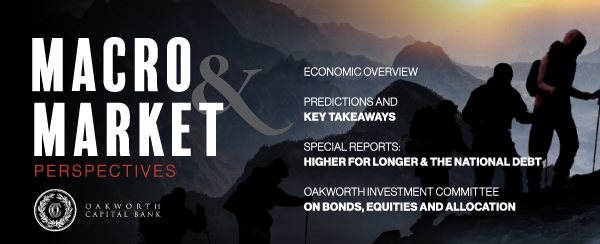Even if the Gross Domestic Product (GDP) report for the 3rd quarter ultimately looks different than it did the first two quarters of 2023, the economic data felt very similar in a lot of ways. The regional purchasing managers indices were unimpressive, if not depressing. Traditional borrowing and lending continued to be sluggish, just as they were during the 2nd quarter.
EXISTING CONCERNS
- The money supply, as defined by the M2 index, barely budged.
- Leading economic indicators have been negative for the past 17 consecutive months.
- Inflation is still higher than the Federal Reserve’s traditional 2%, and the Fed might have another 25-basis point rate increase up its sleeve.
I feel like I could have written that three months ago, even if I didn’t.
Regardless, the labor markets remained surprisingly strong given the weakness elsewhere.
- Job openings, although lower than they had been, were still plentiful.
- The Labor Force Participation and Employment to Population ratios both ticked up during the quarter.
- Finally, the unemployment rate was a miserly 7% in August.
This is important, because personal consumption expenditures drive the U.S. economy. They constitute roughly 70% of the GDP equation. So, it is fair to say “how goes the U.S. consumer is how goes the U.S. economy.” And what do you create when you create jobs and grow the workforce? That’s right… consumers.
In a lot of ways, in best describing the 3rd quarter of 2023, you could say “the more things change, the more they stay the same.”
So much so, many of the conversations I had during the quarter were more about larger picture topics than the actual economic data. It seemed, or seems, a lot of people have the same questions and concerns. Essentially, the present can take care of itself, but what about the future?
FUTURE CONCERNS: THE NATIONAL DEBT
Of particular concern is the continued growth in the national debt, with no apparent end in sight. Certainly, this will ultimately crush economic growth and the U.S. Treasury will have to default on its debt. Right? At $30+ trillion and growing, how could it not?
- First things first: the United States will never have to involuntarily default on its debt. By never, I mean just that, never. Not in my lifetime or the lifetimes of anyone reading this The reason is simple: the U.S. Treasury borrows in its own currency. It doesn’t borrow in euro, yen, British pounds, Swiss francs or Brazilian reals. It doesn’t have to do so.
With this in mind, what could, or would, the Treasury do if it ever got to the point that it simply couldn’t repay the public debt? That’s right. It would turn on the proverbial printing presses, and create money out of thin air. To be sure, this would be inflationary, and the dollar would decline in value, but the Treasury wouldn’t have to default.
- Second, the United States collects far more revenue than its debt service, as in trillions of dollars more. Therefore, the Treasury can continue to service its debt obligations, almost until Doomsday. On the other hand, this would mean other forms of spending would have to get the ax, and they would. While this would be politically unpopular, it would be a much better alternative than the sharp global depression a U.S. default would engender.
In essence, it is currently hard to imagine a scenario where the United States would involuntarily default on its debt. Any default would be voluntary, and would lead to disastrous economic results, ruinous even.
But will this avalanche of debt ultimately crush domestic economic activity? The short answer for that is no. It won’t crush it, but it could slow it down significantly.
Recently, I have been using the following analogy to describe the ultimate impact the debt will have on U.S. growth.
Imagine I am in a 100-meter footrace with Usain Bolt, the fastest man in history. You have to bet $100 of your own money on the winner. Do you choose me or Bolt? Clearly, you would be wise to bet on the Jamaican. Now, how about Bolt has to wear 5-pound ankle weights? Still him, right? 10-pound weights? 20-pound, assuming he doesn’t tear his Achilles or ACL? You are probably still better against me, aren’t you?
Now, imagine Usain Bolt has to wear 40-pound ankle weights on each ankle and carry a teenager on his back. How would you wager? While I am sure some of you would continue to bet on the fastest man in the world, even under those conditions, I would probably start getting some money.
The same could be said about how the debt impacts the economy. It slows it down, but it doesn’t stop it altogether, at least not yet. Bolt can still beat your average 50-something man in a footrace wearing 30-pound ankle weights. However, he won’t be doing it in under 10 seconds.
The reason is twofold.
- The more money the Treasury has to pay to service its debt, the less it has to stimulate the economy in other ways. As a result, and as the debt service constitutes an even larger percent of Washington’s spending, there will be less money for other stuff like roads, tanks, buildings, computers and a whole host of other Stated simply, the debt will ultimately constrain fiscal policy.
- Secondly, the more Washington has to borrow, the more it will likely have to pay to do Over the past fifteen years or so, the Federal Reserve and foreign investors have been more than willing to gobble up our debt. According to Bloomberg, official foreign holdings of U.S. Treasury debt at the end of 2008 were $3.1 trillion. As of July 2023, they were just under $7.7 trillion.

The Numbers:
- The Federal Reserve’s balance sheet was roughly $2.24 trillion in December 2008.
- The most recent observation, September 20, 2023, had it at $8.02 trillion, and shrinking at a $700-800 billion annual pace.
- When you combine the two, foreigners and the Fed have gobbled up close to $10 trillion in S. government debt, including mortgage-backed securities, over the last 15 years.
Can we count on them to continue to do so? The quick answer is probably not. The private sector is going to increasingly finance our public debt moving forward. But at what price? The artificially low sub-2% yields where the Fed had an appetite? Again, probably not.
INTEREST RATES
As a result, longer-term interest rates will remain higher, absent a black swan event, and that could put a ceiling on overall activity. See our special report on page 18. After all, investors would be financing prior fiscal mismanagement in Washington rather than allocating resources to higher and better uses.
Regardless, none of this necessarily signals economic ruin, as much as below-potential growth. While not fun, that isn’t a worst-case scenario, either.
THE U.S. DOLLAR
Another frequent concern or question I get is about the status of the U.S. dollar as the world’s primary reserve currency. At some point the dollar is going to collapse, and we are all going to be spending pre-1965 coins for currency. That was when President Johnson approved the Coinage Act of 1965, which took silver out of circulating coins.
This one is a little more difficult. At some point in the future, the U.S. dollar will probably cease to be the world’s primary reserve currency. The Dutch guilder, Spanish silver dollar, French franc and British pound were all at one point the primary global currency, and accepted largely everywhere Europeans conducted commerce.
And then, they weren’t.
However, no one reading this needs to lose a minute of sleep about this happening any time soon. The simple reason being there isn’t currently a viable alternative. What would it be? The Chinese renminbi? What about lack of convertibility do you like? Also, is the Chinese financial system truly liquid and transparent enough to handle the volume of daily trading? Finally, is Beijing fully committed to protecting the individual property rights of foreign investors? Great question.
What about the euro? While a strong second place contender to the dollar, do the disparate economies and countries in the Eurozone make one wonder about its future construction? After all, what do the Cypriots really have in common with the Dutch? The Irish with the Slovenes? The Portuguese with the Latvians? The Finns with anyone?
This is important, because what happens when some of the lesser, and weaker, economies in the Eurozone realize they can’t control their fiscal policy because they can’t control their monetary policy? Frankly, after the turmoil of the last decade, it is nothing short of amazing that Greece hasn’t punted the euro and inflated a new drachma to pay its bills. The same could ultimately, or will, be said of all of the smaller Southern and Eastern European countries within the bloc.
To that end, per capita GDP in Greece is about where it was two decades ago. So, it is hard to argue the euro has greatly benefited the Hellenic Republic’s economy.
GOLD
Finally, what about gold? The quick response is what about it? The longer response is that it simply doesn’t make much sense.
- There isn’t enough of it.
- It is too cumbersome, being a block of metal and whatnot.
- Further, it is unevenly dispersed, extremely so.
For instance, according to gold.org, the United States has gold reserves of 8,133.46 metric tonnes. Conversely, our friends to the north in Canada have none, like zero, as do the Norwegians. Interestingly, the Afghans have 21.87 tonnes of the shiny stuff, whereas Ireland has only 12.04 tonnes. If gold were the answer, Afghanistan would have double the reserves of one of the wealthiest countries in the world.
Frankly, it just isn’t practical given the sheer size of daily global currency transactions, even if gold can be a good long-term store of value in an investment portfolio.
THE BANKING SYSTEM
A final investor concern seems to be the health of the U.S. banking system. It seems the meltdowns earlier in the year of Silicon Valley Bank and First Republic spooked a lot of people, and with good reason. However, were these failures isolated or the start of a greater trend?
The answer to that question is neither.
There is little argument that higher interest rates have had a negative impact on bank balances.
After all, there is an inverse relationship between interest rates and bond prices. When one goes up, the other goes down. As such, the values of bank bond holdings have gotten the whammy as interest rates have gone up.
Thinking back to your Accounting 101 class in college, what happens to company equity, or capital, when asset values go down while liabilities remain the same? Remember deposits are liabilities for banks. That’s right, equity goes down. That is important, because banks lend out money based on their capital, or equity, base.
The less capital a bank has, the less money it can lend. As a result, higher interest rates have negatively impacted a lot of banks’ ability to lend money. In fact, some might be stuck in a zombie state for an extended period of it.
While that sounds scary, the problems are more company-specific than system-wide. To that end, the nation’s money center banks, the systemically important and too-big-to-fail firms, remain flush with cash and capital. This will almost assuredly prevent another 2008 fiasco.
But smaller lenders with which you might not be familiar? That is a different story.
Over the next three to ten years, many of the nation’s roughly 2,400 banks with assets under $500 million will waive the proverbial white flag. That doesn’t necessarily mean they will fail or the FDIC will have to swoop down and find a suitor. Many, if not most, won’t.
It means their balances sheets will prohibit them from making loans and growing, at least to the degree where it makes sense to stay in business. As a result, we should see a large amount of small bank consolidation, especially in more rural or micro-politan areas. This will allow the combined companies to eliminate redundancies, otherwise known as cut costs, in order to grow the bottom line.

Economic growth could be slowed across many geographic locations while this consolidation happens. Obviously, this could also exacerbate the economic disparities between the nation’s urban and rural settings. As difficult as that might be for many, it should not be a system collapse and a widespread panic.
CONCLUSION
In the end, the data during the 3rd quarter was just as weird as it was during the first two quarters of the year. Despite all of the negative news and apparent sluggishness, the economy has been very resilient in creating jobs. This has created enough of a tailwind to help us continue to grow and avert everyone’s worst-case scenarios.
However, it hasn’t been enough to placate all of our long-term fears.
Hopefully, this quarter’s economic overview helped to salve some frayed nerves. In summary,
- It doesn’t appear the banking system is going to collapse.
- The dollar is not endangered of losing its reserve status.
- Gold, the euro and the renminbi simply aren’t the answers.
- Further, the United States will never have to involuntarily default on its debt. That doesn’t mean Washington’s profligate ways won’t slow economic growth — they Fortunately, they won’t crush it.
Finally, Usain Bolt is much faster than I am until you put 40-pound ankle weights on each leg and a teenager on his back. If the visual of me huffing and puffing down the track being chased by a man laden down with all of that stuff doesn’t give you a smile, nothing will.
This content is part of our quarterly outlook and overview. For more of our view on this quarter’s economic overview, inflation, bonds, equities and allocation read our entire 3rd Quarter 2023 Macro & Market Perspectives.

The opinions expressed within this report are those of the Investment Committee as of the date published. They are subject to change without notice, and do not necessarily reflect the views of Oakworth Capital Bank, its directors, shareholders or employees.



